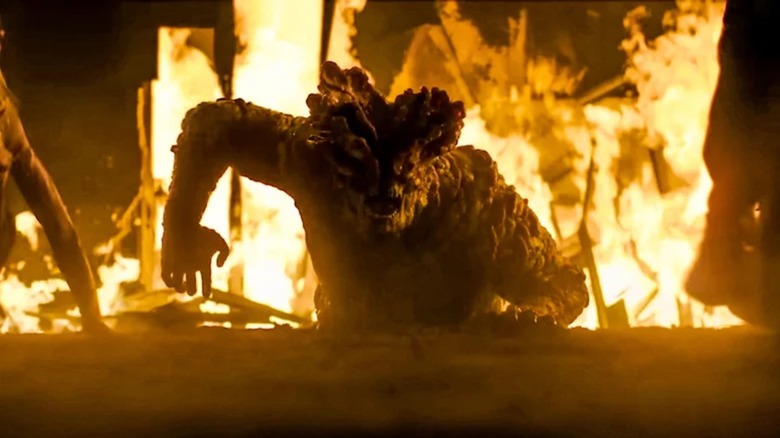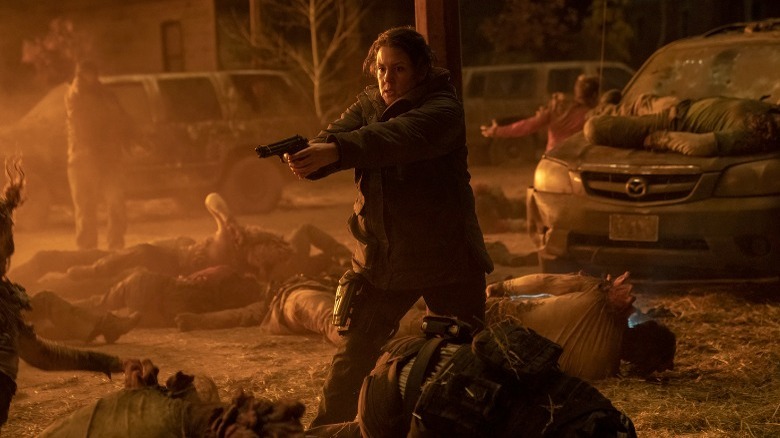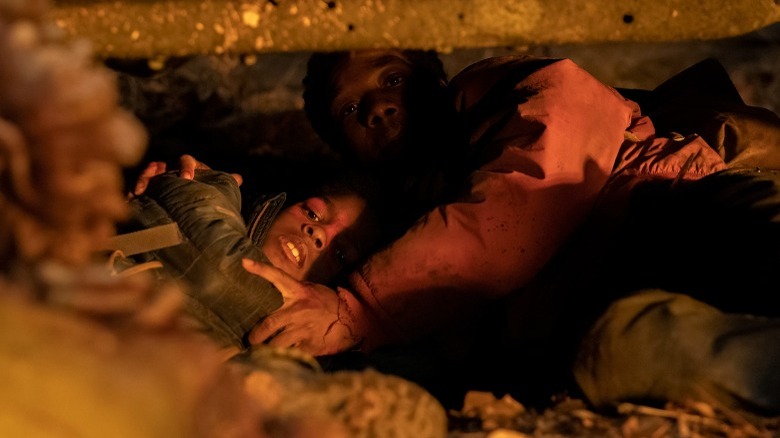How HBO's The Last Of Us Made The Bloater Even Scarier Than It Was In The Game
"The Last of Us" is a story full of very human monsters. The series' post-apocalyptic landscape is crawling with smugglers, killers, power-hungry people, and various bad guys who have been hardened by their need to survive. It's easy to forget, then, that the story is also about cool mushroom zombies whose heads turn into fungus after their hosts fall prey to a fast-moving infection that also turns them rabid.
The fifth episode of "The Last of Us" didn't forget, though. All of the bellyachers who won't stop tweeting "where are all the zombies?" finally have their answer, because it turns out a whole busload of them were all hanging out beneath the streets of Kansas City. Among them? A bloater, one of the video game's most instantly recognizable images. The massive, strong monster came to life via a mix of practical effects, live performance, and VFX in the show, with Variety reporting that 6'6" stuntman Adam Basil donned the 88-pound bloater suit to portray the infected strong man in the show. "Game of Thrones" and "Stranger Things" prosthetics guru Barrie Gower designed the costume.
In the game, you're expected to defeat the bloater
In the latest episode of the official podcast for "The Last of Us," series co-creators Craig Mazin and Neil Druckmann spoke about bringing the bloater to the TV adaptation, and explained that while he was the game equivalent of a boss battle, it became clear while making the show that he wouldn't be as easy to kill on screen. "This is sort of one of those differences between television and games," Druckmann said. "When the bloater comes out in the game, you understand you have to kill it." As he and Mazin pointed out, dispatching such a strong opponent requires multiple weapons like Molotov cocktails, nail bombs, and a shotgun. As podcast host and "The Last of Us" game voice actor Troy Baker pointed out, though, Ellie and Joel don't have all those things lying around in the show.
Druckmann said the pair were torn about whether or not to include a bloater in the series: "Should we do bloater, should we not? We had this, like, back-and-forth for months before we just said, 'Let's definitely do a bloater.'" As the pair explained on the podcast, bloaters are a rarer result of the cordyceps infection timeline than newly infected runners, echolocation-driven, fully bloomed clickers, or people who don't go feral at all but simply die and "become part of the environment that grows all over the walls and the ceiling and the ground."
'No one's killing it, ever'
In the world of "The Last of Us," bloaters are basically people whose bodies are so considerable that the cordyceps works with their muscles' strength rather than diminishes it, keeping them moving after other infected have wasted away. As Mazin put it, "there are certain people that are just so strong and big that could survive even longer, and those are the bloaters." In the game, Druckmann pointed out, players run into a bloater in a school gym during a level in which Joel and Ellie are working with Bill. "The point is, you've got to kill it," Druckmann said. In the show, it's a little different. Mazin said: "Whatever this thing is, and however it got that way, there was this notion that it might be scarier if at some point you realize you're not killing it. No one's killing it, ever."
When the climax of this week's episode gets going, it moves quickly enough that casual fans may not have registered the way the show changes the bloater's story, but as Mazin and Druckmann pointed out, there's something freaky about an enemy you simply can't beat. People die easily, but the earth's natural processes live on. In a frenzy of carnage that includes gunfire, explosions, infected attacks, and fire, the bloater seems completely unbothered. He's the infected equivalent of a cockroach on doomsday, or the last flower blooming up through the dead earth. As far as we know, he'll keep stomping around Kansas City for the rest of the series, ripping heads from bodies like he's popping caps off of bottles.


